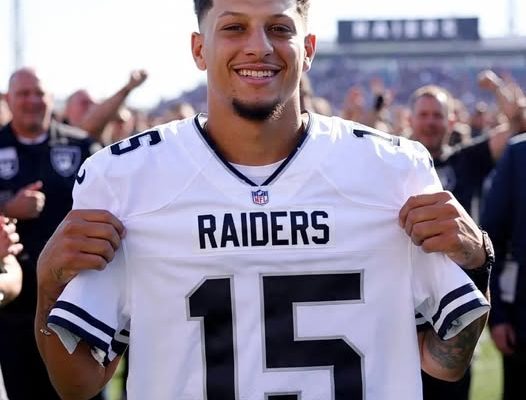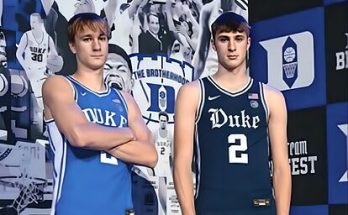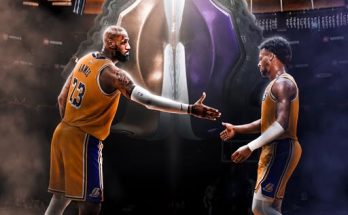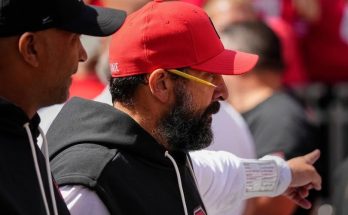There are moments in the sporting world that completely change the landscape of a league, that rewrite legacies, and that leave fans speechless in disbelief. What just occurred in the National Football League may be one of those rare seismic events. The Kansas City Chiefs, a team that has dominated the AFC under the leadership of Andy Reid and their generational quarterback Patrick Mahomes, have reportedly traded Mahomes to the Las Vegas Raiders in a move that is already sending shockwaves across the entire NFL. This isn’t just any trade—it’s the kind of transaction that alters the course of a franchise, shatters expectations, and resets the balance of power in the league. For Chiefs fans, it’s a gut punch; for Raiders fans, it’s the beginning of a dream. But for the NFL at large, it is something that must be unpacked thoroughly—not just for its shock value, but for its unprecedented nature and far-reaching implications.
Patrick Mahomes, often considered the face of the NFL since the retirement of Tom Brady, wasn’t just a star player in Kansas City—he was a cultural icon, the kind of player around whom an entire organization, city, and even generation of football fans rallied. Drafted 10th overall in the 2017 NFL Draft, Mahomes became the starter in 2018 and promptly took the league by storm with 5,097 passing yards, 50 touchdowns, and an MVP award in his first full season. What followed was nothing short of historic: five straight AFC Championship Game appearances, three Super Bowl appearances, and two Lombardi Trophies. Mahomes had become synonymous with winning, and the Chiefs were widely expected to remain contenders for the foreseeable future.
So, what could have possibly led to such a colossal decision? For the Chiefs to willingly move on from a player of Mahomes’ caliber, several layers of motivation must be examined. First and foremost, it’s essential to consider the financial mechanics of NFL team-building. Mahomes signed a 10-year, \$450 million extension with the Chiefs in 2020—the largest contract in sports history at the time. While the Chiefs managed to structure it in a cap-friendly way early on, eventually the back-loaded payments and roster bonus escalators began to strain the team’s ability to remain flexible and surround Mahomes with the kind of talent needed to consistently win.
This past offseason, the Chiefs were already beginning to make difficult decisions. Veterans like Chris Jones were allowed to walk, and other key contributors on both sides of the ball were either traded or left in free agency. Rumors began circulating that Kansas City was looking to reset financially, though few believed that would ever include parting ways with their franchise quarterback. Yet, in a league that thrives on unpredictability and calculated risks, even the unthinkable can become reality.
The Raiders, on the other hand, were desperate for a spark. Despite their flashy relocation to Las Vegas, the franchise had largely remained mired in mediocrity, failing to establish a consistent quarterback presence since the days of Derek Carr, who was released in 2023. The last two seasons saw revolving doors at quarterback, and despite having stars like Davante Adams and Maxx Crosby on their roster, the Raiders had failed to string together playoff-worthy performances. When Antonio Pierce was promoted to head coach and Tom Telesco hired as general manager, it was clear the franchise wanted a bold reset. But few could have predicted just how bold.
Landing Patrick Mahomes wasn’t just a splash—it was a tidal wave. It required mortgaging the future, giving up an unprecedented haul of draft picks including three first-rounders, two second-rounders, and multiple starters on rookie contracts. Financially, the Raiders had to agree to absorb Mahomes’ remaining contract obligations, which they reportedly restructured immediately to spread out the cap hit. But none of those hurdles outweighed the benefit: acquiring the best quarterback in football. Mahomes instantly transforms the Raiders from an afterthought in the AFC West into a true contender. He brings with him not just elite arm talent, but a level of poise, leadership, and improvisational genius that few quarterbacks in NFL history have ever possessed.
For Kansas City, the logic behind the move may be more about long-term sustainability than short-term gain. With Mahomes now off the books, the Chiefs suddenly find themselves with immense salary cap flexibility. The draft capital acquired in the trade provides them with the ammunition to reload quickly and rebuild through a younger, more cost-controlled core. Word has it that Kansas City is particularly high on backup quarterback Carson Beck, the rookie they drafted late in the first round out of Georgia. Beck, though unproven, was known in college for his intelligence, accuracy, and command of a pro-style offense. He now steps into arguably the biggest shoes in the league, tasked with leading a team whose identity has been tightly bound to Mahomes for nearly a decade.
In the locker room, the move is sure to cause a cultural ripple. Mahomes wasn’t just the star player—he was the tone-setter, a magnetic presence that drew free agents, inspired teammates, and created a belief that the Chiefs were never out of any game, no matter the score. His departure forces a reevaluation of leadership dynamics, and it places greater pressure on remaining veterans like Travis Kelce and Nick Bolton to maintain continuity and instill confidence in the younger players. For head coach Andy Reid, who is nearing the twilight of a Hall of Fame career, this trade may signal the beginning of a farewell tour of sorts—a final challenge to build one more contender without the player who defined his second coaching era.
From a league-wide perspective, this trade introduces a fascinating new dimension to the AFC West. The Chiefs, Broncos, Raiders, and Chargers have been locked in a perpetual arms race, but until now, Kansas City had the decisive upper hand thanks to Mahomes. Now, with Mahomes donning the silver and black, Las Vegas may leapfrog into the pole position. The Mahomes-Adams connection has the potential to be one of the most explosive quarterback-receiver duos in football, especially given Adams’ elite route-running and catch radius. Pair that with Josh Jacobs in the backfield and a revamped offensive line, and suddenly the Raiders’ offense could be as dynamic as any in the league.
Defensively, the Raiders have invested heavily in young talent over the past few years, and with the offense now in capable hands, the defense may benefit from more favorable game scripts and reduced pressure. On the flip side, the Chiefs must now contend with the possibility that their former star could routinely beat them twice a year. It’s a psychological twist that adds spice to an already bitter rivalry. Arrowhead Stadium will be buzzing—perhaps with mixed emotions—the first time Mahomes returns in a Raiders uniform.
From an educational standpoint, this trade also offers a masterclass in NFL economics, team management philosophy, and risk assessment. Football, unlike basketball, is heavily dependent on roster balance. One elite player, even at quarterback, cannot consistently carry a weak supporting cast. The Chiefs’ front office understood this, and rather than risking years of slow decline around a top-heavy payroll, they opted to press the reset button in the boldest way possible. It’s a cold, calculated decision that reflects the ruthlessness sometimes required in professional sports. It also underscores how difficult it is to maintain a dynasty in the modern NFL—free agency, salary caps, and player empowerment all conspire to make sustained success increasingly elusive.
For fans, this is a moment of whiplash. Chiefs loyalists are grappling with a wave of emotion, ranging from betrayal to disbelief. Some will question the front office’s sanity, others will call for Reid and Veach to be fired. But in time, many may come to understand the strategic calculus behind the move, especially if Kansas City’s rebuild bears fruit quickly. For Raiders fans, it’s pure euphoria. After years of being the punchline in AFC West jokes, they now have bragging rights and the league’s brightest star leading their offense. Allegiant Stadium will be the epicenter of primetime games, jersey sales will skyrocket, and the city of Las Vegas will embrace Mahomes like a king.
There are also broader implications for the NFL’s media and marketing machinery. Mahomes had become a central figure in the league’s branding, from commercials to international outreach. How the league pivots to promote the Raiders as a flagship franchise—something the league had been hoping for since the Vegas move—will be fascinating to watch. Expect the Raiders to feature heavily in national windows, including Sunday Night Football, Monday Night Football, and international games. The league knows star power sells, and Mahomes remains the ultimate draw.
From the players’ union perspective, this trade also reinforces how fragile “security” in the NFL truly is. Mahomes, despite signing a contract many believed tied him to Kansas City for life, was moved because the math no longer worked. It’s a cautionary tale for players and agents alike to always be prepared for the unexpected—and to ensure that guaranteed money, no-trade clauses, and player options are thoroughly considered during negotiations.
College quarterbacks entering the league will also be affected by this trade. The Chiefs, now in rebuild mode, could become a highly attractive destination for future rookies, especially with the culture and coaching infrastructure still intact. Similarly, veteran quarterbacks still on the market or in unstable situations may start viewing Kansas City differently. And for Mahomes, this trade could be a legacy-defining test. Can he win in a new city? Can he replicate his magic without Reid’s creative genius? Can he lift a historically inconsistent franchise to Super Bowl heights?
Legacy is perhaps the most compelling lens through which to view this trade. For Mahomes, it’s a departure from comfort and the beginning of a new challenge. For Andy Reid, it may be the final test of his adaptability and teaching brilliance. For the Chiefs’ front office, it’s a chance to prove that a franchise is bigger than any one player. And for the Raiders, it is an opportunity to finally shed the stigma of dysfunction and build something worthy of their proud, rebellious history.
In the final analysis, this is more than a transaction—it’s a tectonic shift. The NFL, a league known for parity and unpredictability, just witnessed one of the most daring, landscape-altering moves in its history. And whether it ends in triumph or regret for either party, it will be studied, debated, and remembered for generations to come. Trades like this don’t just change teams—they change legacies, rewrite rivalries, and shape the future of the league. The Patrick Mahomes trade is now one of those moments. The shockwaves have only just begun.



